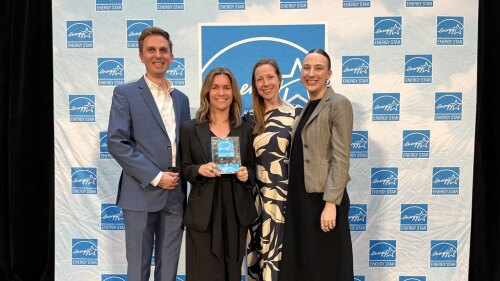In September, ULI hosted subject matter experts on the potential impacts of the Inflation Reduction Act on the commercial real estate industry. Panelists discussed the tax incentives, deductions and credits geared to encourage building owners to deploy clean energy and energy efficiency projects and how various sectors and industries plan to participate in this opportunity.
Listen to the webinar in ULI’s Knowledge Finder.
Out of the eighteen tax credits, there are four that Duane Desiderio, senior vice president and counsel, Real Estate Roundtable, believes speak to the commercial real estate sector.
The first incentive goes beyond ASHRAE 90.1 code for energy-efficient buildings by changing the 179D tax deduction. Now, the deduction has been updated “to encourage existing building retrofit projects and also encourages new buildings to be more energy efficient,” said Desiderio.
Desiderio broke down the remaining incentives. The Real Estate Roundtable has also published policy toolkits and fact sheets discussing the incentives.
“The second incentive that we will be getting into is the section 48 investment tax credit…. It is geared to encourage deployment of clean energy and renewable energy projects at facilities, which would include buildings. What we are talking about here are things like solar panels, combined heat and power. IRA adds to the list of investment tax credit technologies, energy storage, and dynamic glass.”
“The third incentive to focus on is the 30C tax credit that encourages the installation of electric vehicle recharging stations…. The EV charging station tax credit only applies to buildings and projects only located in low-income areas so if members have projects in opportunity zones, they might be able to tap into [this].”
“The fourth incentive is a 45L tax credit geared towards energy efficient, residential, new construction, and significant rehabilitation. Here the incentive can apply to single family and multifamily.”
In reference to how these tax credits could work together, Desideiro said, “If you have a particularly larger multi-family building that might need a retrofit… and in that project you might consider the solar panels and EV charging stations, you might qualify for all of these things. There is a connection between IRA credits and labor wages. … If prevailing wages are paid to workers on a project, the incentive amounts plus up by 5.”
Lastly, there may be a possibility of transferring these credits to a third party.

Webinar participants included (clockwise from top left) Daniel Egan, managing director, real estate–ESG Americas, Blackstone; moderator Billy Grayson, executive vice president, ULI Centers and Initiatives; Nicholas Burger, deputy director, D.C. Department of Energy and Environment; Duane Desiderio, senior vice president and counsel, Real Estate Roundtable; and Suzanne Fallender, vice president, global ESG, Prologis.
The panel shifted to looking at the advantages of IRA from the public sector represented by Nick Burger, deputy director, energy, administration, D.C. Department of Energy and Environment.
“... Clean energy D.C. and climate commitments acts [that] commit us to reduce greenhouse emission by 60 percent by 2030 and [be] carbon neutral by 2045. Large commercial and residential buildings are the largest contributors by quite a big margin, so this is the right group to be thinking about if we meet these climate goals.”
On the local level, Burger said there is a need to combine problem solving for multiple intersecting issues.
“The pandemic really expanded possibilities for telework and the District has one of the highest rates in the country…As we are asking ourselves how do we revitalize these spaces? How do we repurpose those buildings? We want to think about how we can reach those goals and bring our energy and climate goals together.”
IRA provides an opportunity for collaboration to solve these issues, aside from building more energy-efficient housing.
“The renewable energy tax credits that [Duane Desiderio] mentioned are important. We are looking to those to meet our solar goals for the district and how we produce solar energy in the district. We are looking to expand solar benefits for households that otherwise might not have access like multi-family…Probably one of the biggest things in the bill that could be beneficial is the greenhouse gas reduction fund. So this is up to $27B dollars which will be deployed in various mechanisms and we are not entirely sure how this is going to work.”
Burger concludes that there are more questions that the District has and would like to learn more about.
“For example, the rebates for appliances and upgrades [are] targeted on individual houses. But there might be ways to take advantage of those rebates on a housing scale. If your building meets certain affordable housing criteria, this might be something a building owner can take into account.”
Suzanne Fallender, vice president, global ESG at Prologis shared the company’s interest in being more sustainable.
“Prologis has a long history of sustainability—green building to solar to building certifications—we are the global leader in logistics real estate … 15 percent of global goods consumption or 2.5 percent of global GDP runs through our network in a given year. We think of that [both] from a responsibility perspective–how do we think about reducing emissions? How do we think about that built environment and what we can do for innovation there? But we are also seeing an increasing opportunity to help really differentiate by helping our customers with their decarbonization goals and their climate goals.”
Regarding the IRA, Prologis has been looking to invest more in electric vehicles and reducing emissions around ports.
“Our ambition is to get to net zero for our own operation and full value chain by 2040. One of the key interim targets is to expand our solar investments. Right now, we have 340 Megawatts of solar and increase to 1 gigawatt of solar by 2025.” Fallender sees the timing of the IRA as good. It intersects with the Prologis’ upcoming builds and retrofits to reduce tenant energy use.
Blackstone—a global investment business global real estate worth $577 billion spread across opportunistic, core plus, debt investment strategies and funds—is represented by Daniel Egan, managing director, real estate–ESG Americas.
“When we refer to the IRA, what we are seeing is the potential to elevate the role that private sector real estate can play in decarbonization and energy transformation. I like the earlier comments. Certainly, commercial real estate bears a large portion of emissions coming out of cities. In addition to reducing energy, reducing emissions, I think real estate can play a meaningful role for distributed generation, dispatchable energy assets, certainly onsite solar production and energy storage, and real estate a more reliable partner for demand response.”
Regarding Blackstone’s interest in IRA, Egan mentioned that Blackstone has “a 15 percent emission reduction goal within the first three years of investment when we are in control of the energy usage” and would be interested in participating should there be an opportunity to do so.
A recording of the webinar is available in ULI’s Knowledge Finder.




